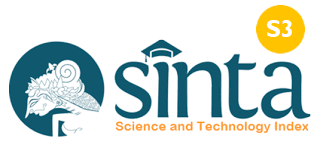Penerapan Srtategi Pembelajaran Think Talk Write (Ttw) Bermedia Gambar Untuk Meningkatkan Aktivitas Belajar Dan Keterampilan Menulis Puisi Siswa
Abstract
This study aims to improve; learning activities and skills to write poetry students of class VII-B SMP Negeri 5 Abang semester 2 year lesson 2016/2017. This study used a classroom action research design through two cycles. Student learning activity data is collected by observation sheet, and data of student poetry writing skill is collected by test method which is analyzed by quantitative descriptive method. Before the second cycle is done, firstly done rekavitulasi data writing creative value of class VII students three years previous lessons, and asked the previous teacher of Indonesian language about student learning activities combined with the results of observations of teachers of researchers on previous learning. This data is used as initial data of learning activity and skill of writing poetry of class VII student at SMP Negeri 5 Abang. The result of the research shows that the implementation of talk-writing write (TTW) strategy with the help of picture media can increase the learning activity and poetry writing skill of VII-B students of SMP Negeri 5 Abang 2nd semester of academic year 2016/2017, that is the average of student learning activity on cycle I was 70 (positive enough category) with 52% classical completeness, while in cycle II the average of student learning activity was 80 (positive category) with 89% classical completeness. The average student's poetry writing skills also increased significantly from the average of 72, 72% absorption, 63% classical completeness in cycle I, the average score of students' writing poetry skills is 75, absorbency 75%, and mastery classical 89% in cycle II.
References
Arsyad, Azhar. 2011. Media Pembelajaran. Jakarta : Rajawali Pers.
Julianti, Laila. 2014. “Penerapan Strategi Pembelajaran Tink Talk Write (TTW) dengan Media Gambar untuk Meningkatkan Kemampuan Menulis Puisi Siswa Kelas VB SDN 68 Kota Bengkulu”. Skripsi (tidak Diterbitkan). Bengkulu: Prodi PGSD, Jurusan Pendidikan Universitas Negeri Bengkulu.
Musfiqon. 2012. Pengembangan Media Dan Sumber Belajar. Jakarta: PT. Prestasi Pusta Karya
Rezaliah. 2013. Makalah. Model Pembelajaran Tipe Think, Talk, Write. Dalam http://resaliah.blogspot.co.id/2013/06/makalah-model-pembelajaran-tipe-think.html. diakses 9 Aprl 2017, pukul 20. 09 Wita
Sudarsana, I. K. (2018). Pengaruh Model Pembelajaran Kooperatif Terhadap Peningkatan Mutu Hasil Belajar Siswa. Jurnal Penjaminan Mutu, 4(1), 20-31.
Sudarsana, I. K. (2018). Optimalisasi Penggunaan Teknologi Dalam Implementasi Kurikulum Di Sekolah (Persepektif Teori Konstruktivisme). Cetta: Jurnal Ilmu Pendidikan, 1(1), 8-15.
Yamin, M. & Ansari B.I. 2009. Taktik Mengembangkan Kemampuan Individual Siswa. Jakarta: Gudang Persada Press.
Yulianto. 2009. “Peningkatan Kemampuan Menulis Puisi dengan Media Gambar Karikatur Melalui Teknik Pancingan Kata Kunci Siswa Kelas VIII F SMPN 13 Semarang”. Skripsi (tidak diterbitkan). Semarang: UNNES.
Downloads
Published
How to Cite
Issue
Section
License
An author who publishes in the Cetta : Jurnal Ilmu Pendidikan agrees to the following terms:
- Author retains the copyright and grants the journal the right of first publication of the work simultaneously licensed under the Creative Commons Attribution-ShareAlike 4.0 License that allows others to share the work with an acknowledgement of the work's authorship and initial publication in this journal
- Author is able to enter into separate, additional contractual arrangements for the non-exclusive distribution of the journal's published version of the work (e.g., post it to an institutional repository or publish it in a book) with the acknowledgement of its initial publication in this journal.
- Author is permitted and encouraged to post his/her work online (e.g., in institutional repositories or on their website) prior to and during the submission process, as it can lead to productive exchanges, as well as earlier and greater citation of the published work (See The Effect of Open Access).
Read more about the Creative Commons Attribution-ShareAlike 4.0 Licence here: https://creativecommons.org/licenses/by-sa/4.0/.





